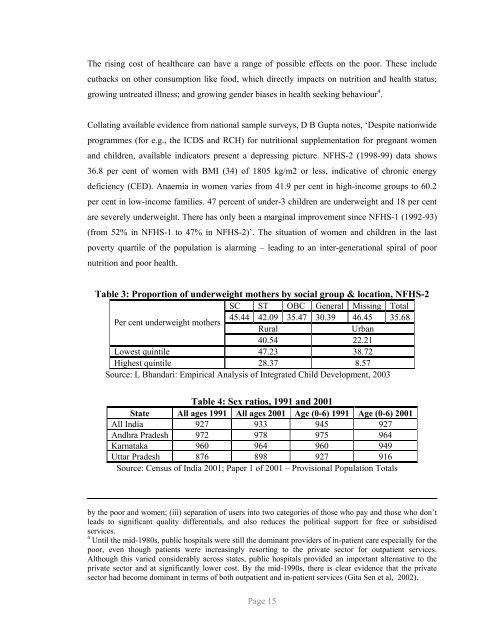Snakes and Ladders - ERU Consultants Pvt. Ltd.
Snakes and Ladders - ERU Consultants Pvt. Ltd.
Snakes and Ladders - ERU Consultants Pvt. Ltd.
You also want an ePaper? Increase the reach of your titles
YUMPU automatically turns print PDFs into web optimized ePapers that Google loves.
The rising cost of healthcare can have a range of possible effects on the poor. These include<br />
cutbacks on other consumption like food, which directly impacts on nutrition <strong>and</strong> health status;<br />
growing untreated illness; <strong>and</strong> growing gender biases in health seeking behaviour 4 .<br />
Collating available evidence from national sample surveys, D B Gupta notes, ‘Despite nationwide<br />
programmes (for e.g., the ICDS <strong>and</strong> RCH) for nutritional supplementation for pregnant women<br />
<strong>and</strong> children, available indicators present a depressing picture. NFHS-2 (1998-99) data shows<br />
36.8 per cent of women with BMI (34) of 1805 kg/m2 or less, indicative of chronic energy<br />
deficiency (CED). Anaemia in women varies from 41.9 per cent in high-income groups to 60.2<br />
per cent in low-income families. 47 percent of under-3 children are underweight <strong>and</strong> 18 per cent<br />
are severely underweight. There has only been a marginal improvement since NFHS-1 (1992-93)<br />
(from 52% in NFHS-1 to 47% in NFHS-2)’. The situation of women <strong>and</strong> children in the last<br />
poverty quartile of the population is alarming – leading to an inter-generational spiral of poor<br />
nutrition <strong>and</strong> poor health.<br />
Table 3: Proportion of underweight mothers by social group & location, NFHS-2<br />
SC ST OBC General Missing Total<br />
Per cent underweight mothers<br />
45.44 42.09<br />
Rural<br />
35.47 30.39 46.45<br />
Urban<br />
35.68<br />
40.54 22.21<br />
Lowest quintile 47.23 38.72<br />
Highest quintile 28.37 8.57<br />
Source: L Bh<strong>and</strong>ari: Empirical Analysis of Integrated Child Development, 2003<br />
Table 4: Sex ratios, 1991 <strong>and</strong> 2001<br />
State All ages 1991 All ages 2001 Age (0-6) 1991 Age (0-6) 2001<br />
All India 927 933 945 927<br />
Andhra Pradesh 972 978 975 964<br />
Karnataka 960 964 960 949<br />
Uttar Pradesh 876 898 927 916<br />
Source: Census of India 2001; Paper 1 of 2001 – Provisional Population Totals<br />
by the poor <strong>and</strong> women; (iii) separation of users into two categories of those who pay <strong>and</strong> those who don’t<br />
leads to significant quality differentials, <strong>and</strong> also reduces the political support for free or subsidised<br />
services.<br />
4 Until the mid-1980s, public hospitals were still the dominant providers of in-patient care especially for the<br />
poor, even though patients were increasingly resorting to the private sector for outpatient services.<br />
Although this varied considerably across states, public hospitals provided an important alternative to the<br />
private sector <strong>and</strong> at significantly lower cost. By the mid-1990s, there is clear evidence that the private<br />
sector had become dominant in terms of both outpatient <strong>and</strong> in-patient services (Gita Sen et al, 2002).<br />
Page 15












